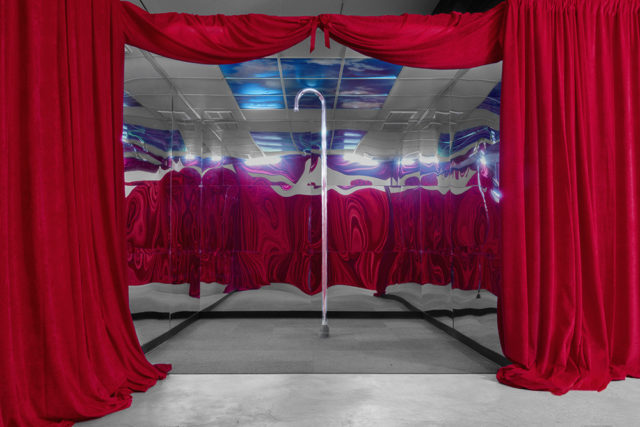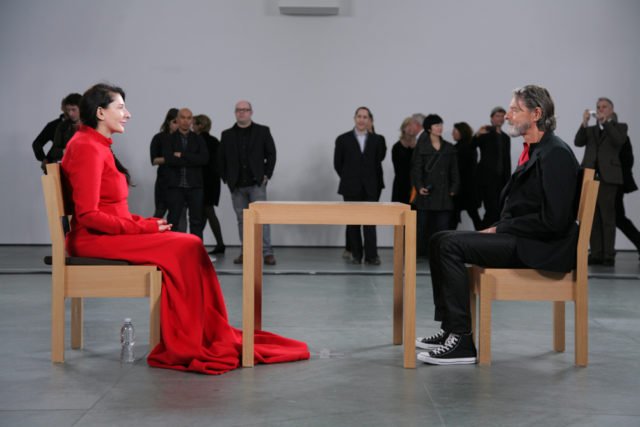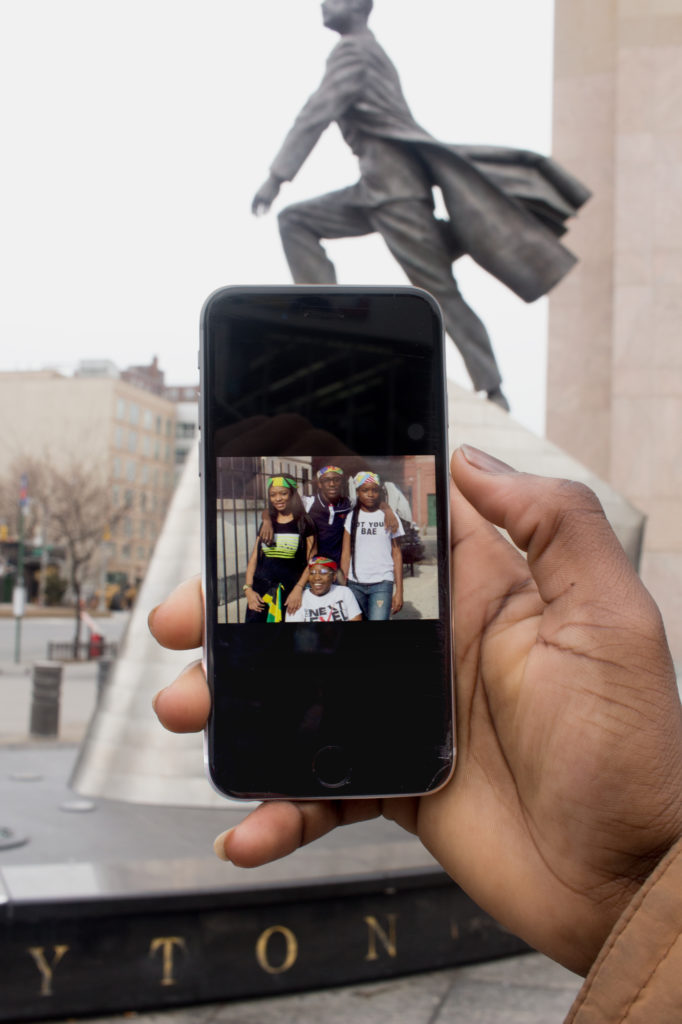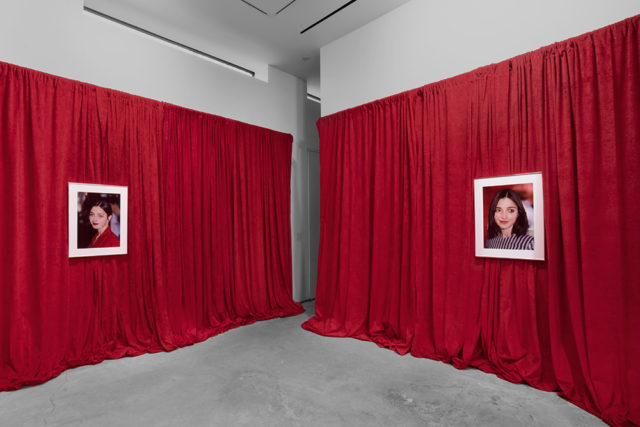This spring at James Fuentes in New York, Amalia Ulman showed a collection of works under the title Dignity, running March 3 to April 2. The installation was framed as the aftermath of the artist’s 2016 performance ‘Privilege’ in which she interrogated “Whiteness, maleness, verticality, and linearity as the dominant aesthetic of power and legitimacy” in the workplace and contrasted these normative hierarchies in labour conditions with her own privileged yet constricted position as an artist. In New York, the exhibition space was hung with red curtains on top of which were glossy photos of Ulman’s head and shoulders, posing as a celebrity would on the red carpet, superimposed on her face was semen as if she’d been ejaculated on. One section of the gallery was set apart from the curtained room, mirrored with distorting acrylic, in the middle of it was a stripper pole in the shape of an outsized walking cane. A sound track of pigeons played obliquely, in reference to the Bob 2.0 pigeon robot included in Privilege. The coo-ing sound contributed to a feeling of recent evacuation the viewer experienced upon entering the room; it felt as if you had just missed something, no stripper was present and only the trace of an orgasm was left, on a replica image of the artist.

In the labour economies that Ulman’s second instillation invokes, notably sex or pornographic work as suggested by the pole and the images, and care work as again suggested by the pole/ walking stick, dignity is indeed a privilege. Professional caregiving is an industry which intersects between the private and public sector. On a state level, where the state still provides it, care is frequently delivered by the least economically independent to the least physically able people in society. This necessary allegiance between the differently-abled produces a bond which is predicated on dependency and held in place by wage relations. Neither the role of caregiver or receiver is privileged, socially or economically. The relationship exists to produce a standard of living for the giver, which allows them economic dignity and it exists to provide the care receiver to live with a governmentally-assessed standard of quality of life. Sex work and pornography, in a parallel fashion, require a relinquishing of the barriers to intimacy — a degree of bodily disclosure at least at the level of the image, of what is politely considered private, for financial compensation. There are correlations between these forms of labour but they are not one and the same. However, within both of them dignity is rendered a privilege through its economic evaluation. It is this evaluation that reproduces dignity as an aspiration.

Ulman’s own experience with ill health, physical trauma and the financial implications of those experiences undoubtedly underpins the Dignity exhibition. It is in this complicated nexus of dependency, domination, economic servitude and self-preservation, that the artist appears with semen digitally applied to her face. The image is provocative but not hugely complicated in its own right, but what it poses is a series of questions about how the artist chooses to appear within and then recede from the socio-economic scene she depicts. The binding and common experience of those who perform labour through their bodies, for the bodies of others, is the need to be present. The affective eeriness of the Dignity installation was produced through the lack of bodily presence and a sense that the body required to perform the task of pole dancing, or as a surface for semen, should be and is not there. In this scenario, the choice to not be present is an artistic intervention that problematizes the labour conditions that Ulman sets out to examine and reveals others that are more implicitly present in her artistic production.
In her essay ‘The Total Terror of Dasein: Economies of Presence in the Art Field’ Hito Steyerl writes, “The economy of presence is not only relevant for people whose time is in demand and who could basically sell (or barter) more time than they have,” as an explanation of how being present, and offsetting physical presence against the choice and ability to not to be, has become its own sub-economic strata. The artist, writer and film maker’s text is framed around a history of artist strikes and develops her theories of artistic labour under neoliberal economic conditions. For Steyerl ‘presence’ has become the most significant aspect of work. In ‘The Total Terror of Dasein’ Steyerl writes an equivalence between Marina Abramović’s 2015 performance The Artist is Present, and task-based and service industry employment. Except that Steyerl’s Marxist class-consciousness does not permit her to totally collapse these states, and her essay describes how those who are literate in this economy of presence utilise proxies so as to not have to show up themselves. In the case of Ulman’s practice the proxy is her image reproand her performance practice exists exclusively in that space of representation. This is in contrast to Abramović’s obstinate, to the point of unnecessary, durational and physical performance. The artists adopt different strategies and techniques but converge over the idea of choice. Abramović mines her own reputation and status, making herself nominally available to her audience, while Ulman utilises an ‘online presence’ as a form of performance that splits her image from her body and puts the image to work in her absence.

It is very chic to choose to not attend your own birthday party. That ability to resist the demand, is a luxury not permitted those who are subject to wage labour, family responsibility, criminal conviction or myriad conditions that make us obligated to attend, serve, participate. Agility, elegance, grace and dignity. These qualities are the preserve and property of those who belong to particular class positions and are further coded in terms of race and gender. There is an aspect of Ulman’s instagram performances, particularly the work from 2014 where she falsified a breast re-augmentation surgical procedure, that carries the taint of class drag. That is, drag not as a critical performative intervention, but drag as masquerade and pageantry. Any form of top-down appropriation cannot be radical, as such Ulman’s ability to glide in and out of the spaces and identities she chooses to inhabit reinforces the privilege that she aims to critique. Of course, with a knowing wink, she is not without self-knowledge, and her personal experiences with illness have fed explicitly into her art practice. However, what is not present in Ulman’s investigation is an acknowledgement of class structure or the material particularities of experience. As Marxist theorists confirm, including Steyerl, representation in the labour market is not equally distributed. Returning to the example of Abramović, who received robust criticism for her use of actors/participants as table decorations at the MOCA gala dinner in 2011, not everyone appears with the same set of tools. What is a practice like Ulman’s without the assumption of the right to perform or the ability to refuse?

American Artist is a young practitioner who works across media — text, video and installation — to examine the power structures that form and are reproduced by technology. Their work is specifically focused on digital communications and social media and the racial violences that are perpetuated through these systems. In 2015, American Artist initiated an online performance project called ‘A Refusal,’ in which they covered their social media images with a blank, homogeneous blue colour, described by the artist in a conversation with the author as a ‘palette cleansing’ shade. The colour used only exists on (and can only be represented by) screens, and so directly relates to waiting screens on media and DVD players, an evacuated, yet pregnant space. This performance developed into the Dignity Image (2016) project in, which American Artist interviewed various friends and colleagues, predominantly art practitioners, about their use of social media and the images that they choose not to put into circulation; photos of family, friends or more incendiary scenes. American Artist articulates dignity as a condition which is only achievable through a refusal, or a stepping out of sight.
Ulman is a very skilled and technical performance artist. It is not the emotional or political currency of her work that has made her appealing to both Instagram users and international art institutions. The artfulness of her practice comes from the dexterity with which she multiplies and disperses her image across sites and platforms, and the theoretical knowledge of digital technology that her skill belies. These numerous and repeated dispersals are — as read through Steyerl’s logic — a set of approximations of the artist, which travel freely and smoothly on the physical Ulman’s behalf, when on some occasions she has not been physically able to move. These proxies in a sense divert attention from the ‘real’ artist in question and in doing so preserve her and her dignity as an un-intruded on subject. The reality of Ulman’s labour does not devalue her commentary on the experiences she depicts and performs but it does further entangle that category of privilege with the status of dignity, and perhaps more importantly keeps Ulman’s criticality in the realm of semiotics and out of an inquiry into structure. It is precisely structure and the architectures of representation that are at stake in American Artist’s work.

Like Ulman the technological literacy of the participants in American Artist’s Dignity Image project allow them to narrate the successes and failures they have in moving in and out of spaces of representation. This literacy in itself is a site of privilege most readily available to digital natives in first world countries, but it is a privilege that acknowledges its situated limitations. In a conversation with the author, American Artist stated that one of the uncomfortable truths their project revealed is that while we may gesture towards or perform an act of disappearance, we cannot in actual fact exit the infrastructures of social media-cum-surveillance, which we are semi-willing and semi-forced participants. For example, one can delete Facebook but it’s harder to remove yourself from electronically mapped banking systems, which is a space you are as represented in as your social media accounts. Returning to the idea that dignity is predicated on mobility and choice, American Artist’s work reckons with the sticky infrastructural confines of our lived and mediated lives, whereas, arguably, Ulman’s work is a form of pictorial illusionism.
In a more recent project Sandy Speaks (2016- ongoing) American Artist developed a chatbot that imagines and ventriloquizes the social media posts that Sandra Bland — who died in police custody after being arrested for a driving offence in 2015 — could have made during her time in jail. Bland is one of the names in the relentless list of African Americans killed by law enforcement each year. She was also a civil rights activist who regularly uploaded videos on topics relating to the Black Lives Matter movement and police brutality. These online presentations were interrupted by her incarceration. Bland’s arrest exists as footage recorded by the police but inside the prison, an architecture of enclosure and observation, her self-representation was extinguished. There is no footage of how Sandra Bland died and as such her family have no way to legally counter the verdict of suicide which they believe to be false. A death in custody, the compression of the state apparatus on top of someone is not a dignified death. The gentle intimacy that we hope for at the end of life, and pay to manufacture in the care-giving sector of the state, is not permitted. The continuous action of the state apparatus to obscure what happened to Bland is a forced exit from the sphere of visibility. In American Artist’s re-animation of her, through text not image, is a reckoning with the stakes of visibility for some people.
Amalia Ulman’s Dignity solo exhibition was on at New York’s James Fuentes, running March 3 to April 2. American Artist is showing as part of the Memory is a Tough Place exhibition at New York’s New School, running June 29 to September 3, 2017.













